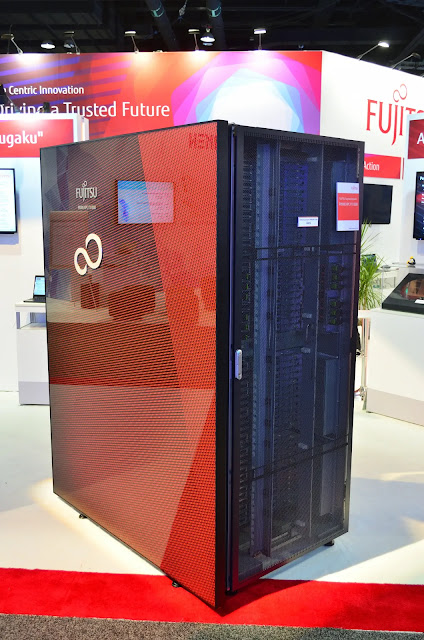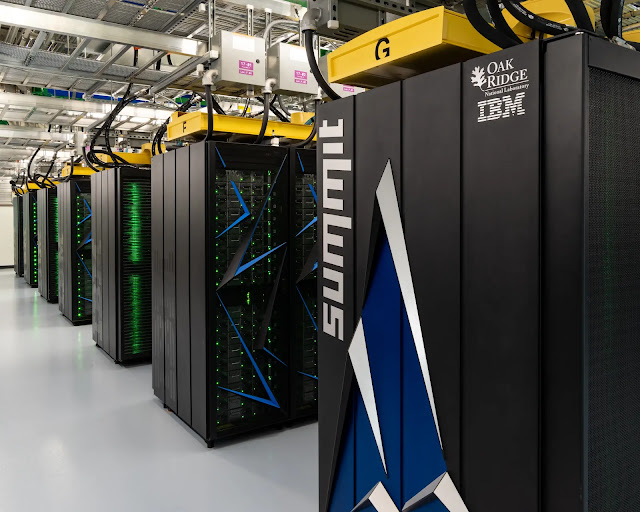Supercomputers are mighty computers that are capable of performing highly complex calculations at extremely high speeds. The speed of supercomputers is now measured in Flops (floating-point operations per second). These machines are designed for use in scientific research, engineering, weather forecasting, and other applications that require massive amounts of computing power. Universally, Seymour Cray is known as the father of the supercomputer.
 |
Super Computer |
A supercomputer typically has
multiple processors working in parallel, as well as specialized hardware for
performing specific types of calculations. They also have large amounts of
memory and storage capacity, often measured in petabytes.
Some examples of the Fastest Supercomputers in the world:
1. Frontier: In the fastest supercomputer world the Hewlett Packard Enterprise Frontier or OLCF-5 is the world's first and fastest exascale supercomputer, located at the Oak Ridge Leadership Computing Facility (OLCF) in Tennessee, United States. It is based on the Cray EX and was first operational in 2022. it is the successor to Summit (OLCF-4), As of March 2023, Frontier is the world's fastest supercomputer.
 |
| Frontier Supercomputer |
It has the capability to achieve a speed of 1.102 exaFLOPS (Rmax) which is 1.102 Quintillion Operations per second, it uses AMD CPU and GPU. The Operating System used in Frontier is Linux (HPE Cray OS-SUSE)
2. Fugaku: Fugaku is currently the most powerful supercomputer in Asia and the second-fastest supercomputer in the world. It is located in Japan. It has a peak performance of 442 petaflops.
3. Summit: Located at Oak Ridge National Laboratory in Tennessee, Summit is currently the one of fastest supercomputers in the world. It has a peak performance of 200 petaflops, or 200 quadrillion calculations per second.
4. Tianhe-2: Tianhe-2 was the fastest supercomputer in the world until it was surpassed by Summit. It is located in China and It has a peak performance of 54.9 petaflops. Supercomputers are used in a
wide range of scientific and engineering applications, including weather
modeling, nuclear simulations, and drug discovery. They are also used in
industry for tasks such as oil exploration, financial modeling, and product
design.
Super Computer in India:
There are several notable supercomputers developed in India over the years of development. Some of them are listed here:-
1. PARAM Super Computer: PARAM stands for "Parallel Machine". It is a series of supercomputers developed in India by the Centre for Development of Advanced Computing (C-DAC) in Pune, India. The first supercomputer PARAM-8000 that can deliver speed in a GigaFlops was launched in 1991, and since then, several models have been developed. PARAM Siddhi-AI launched in 2020 with Nvidea DGX superpod-based networking architecture, HPC-AI engine software frameworks, and cloud platform form C-DAC can deliver speed up to 4.6 to 5.267 PetaFlops. in the development of supercomputers in India there is the great contribution of Mr. Vijay Pandurang Bhatkar, also known as the father of Indian Supercomputers. He is an Indian Computer Scientist, IT Leader, and Educationalist. He is best known as the architect of India's national initiatives in Supercomputing where he led the development of the PARAM supercomputers. he was the founder and executive director of C-DAC and currently working on developing exascale supercomputing.
 |
| Param Supercomputer |
2. Annapurna: Annapurna is a supercomputer developed by the Indian Space Research Organization (ISRO) in Bangalore, India. It is used for space-related research and applications.
4. Pratyush and Mihir Supercomputers: Pratyush is a series of supercomputers established at the Indian Institute of Tropical Meteorology (IITM) in Pune, India. and Mihir is established at National Centre for Medium-Range Weather Forecasting (NCMRWF) in Noida, India. It is used for weather forecasting and climate research.
Pratyush and Mihir are two high-performance computing units (HPC). Pratyush is being 4.0 PetaFlops, and mihir is being 2.8 PetaFlops unit. they provide a combined output of 6.8 PetaFlops computing speed.
These supercomputers have contributed significantly to India's weather forecasting, climate research, scientific research, and development in various fields, including astrophysics, chemistry, and space technology.


